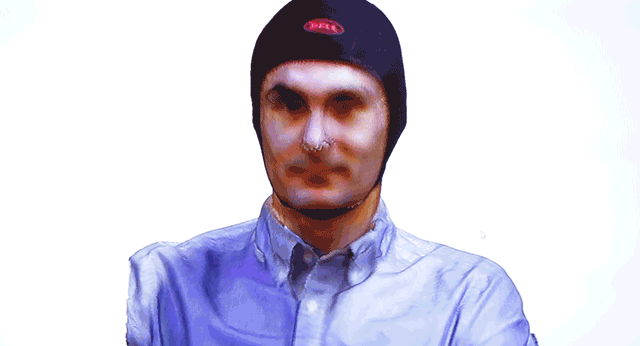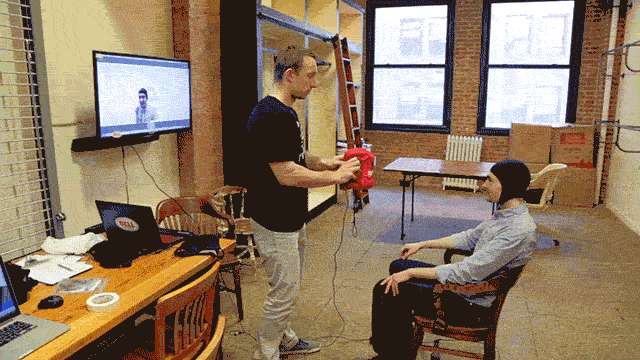It’s not hard to find a badass-looking helmet for your adrenaline-fuelled hobbies. The trick is finding one that fits correctly. For decades, that’s meant buying a standard (S/M/L) size lid and rearranging the padding to conform to your noggin. Recently, I got to try out a much better way.
Bell Helmets wants to bring helmet fitting into the 21st century, using 3D scanning to build a helmet to the exact contours of your head — no matter how weird and lumpy it is.

Getting a proper fitting helmet is about more than just comfort. The best lid in the world won’t do your skull much good if it’s so loose it flies off your head while you’re flying off your machine, while a helmet that pinches, pushes, or prods your noggin is one you’ll be reluctant to wear. Hitting the right balance of snug-but-comfortable, and checking off all the pointers that make sure you’re protected, can be a frustrating game for those of us with oddly-shaped domes. Bell’s new tech hopes to change that.
At a Bell event in New York City, I got the chance to go through the scanning process that makes this helmet customisation possible. Conceptually, it’s pretty simple. After putting on a spandex cap to mash your hair down tight against your skull, you just sit still while a technician walks a proprietary, handheld 3D scanning eye around your head.

In my case, that technician was Joe Tomascheski, senior product developer for parent company Easton-Bell Sports. Once you’ve been scanned, the computer creates a manipulatable 3D rendering of your head, neck, and shoulders. On screen, it looks unsettlingly like a Shapeways schematic for a 3D printed toy.

From these 3D coordinates, Bell makes a fully custom helmet liner that matches the unique contours of your head. This process takes a few days, and is a closely-guarded company secret, so while I wasn’t able to see or try on a customised helmet, Tomascheski explained what happens next.
Once you’ve been scanned, your 3D coordinates are sent back to Bell. They’re used to create a bespoke interior core, which is assembled into a complete helmet. This isn’t a process of tacking pieces of foam into an off-the-shelf lid; instead, it creates a single inner shell of Expanded Polystyrene (EPS), the same material used in stock Bell helmets, but shaped to the exact specs from the 3D scan.
As Tomascheski explained, Bell prototyped the helmet customisation service with powersports athletes for the past year and a half. Since the process involves changes to the way the helmets are constructed, Bell worked directly with both the US Department of Transportation and the independent Snell Foundation to ensure the custom-built helmets meet the most stringent rating requirements.
A key facet in certification was the fact that these designs only add foam thickness where needed — no material is removed from the baseline foam thickness of a standard helmet. Tomascheski was very careful about phrasing this, but he told me that in certain cases during testing, the added foam thickness in the custom-tailored helmets decreased impact force when compared to standard models.
Bell first offered the scanning service to a small group of customers and professional racers at the 2013 Superbike World Championship at Laguna Seca, and it will continue to show the technology at both dirt and street motorcycle events throughout the year. By late 2014, the company hopes to bring the service to about 20 Bell dealers around the United States.
Currently, the company plans to offer the extreme customisation on two of its full-face motorcycle helmets: the street-oriented Star Carbon (the black helmet shown above) and the off-road Moto-9. Exact pricing hasn’t been set, but at around $550-$650 for the helmet, plus an estimated $400 for the custom fitment, this option probably won’t be cheap.
But these are just the first steps toward the future of helmet customisation. Tomascheski tells me that Bell will keep scanned head dimensions on file, making it easy — and cheaper — to order subsequent custom-tailored lids. Plus the data the company gathers will help fine-tune the designs of both customised and off-the-shelf helmets in the future, and the technology might grow to include the company’s Giro brand of bicycle and snow sports helmets.
If you’ve got helmet-wearing hobbies, and you take your brain seriously, that price is probably worth it. Because with helmets, it’s what’s on the inside that really counts.
Pictures: Michael Hession
